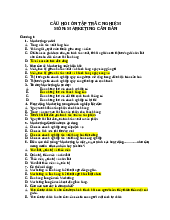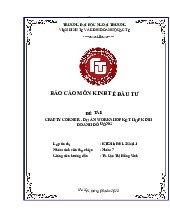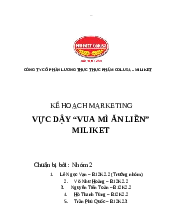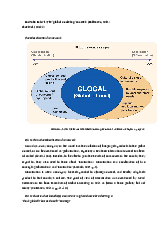


















Preview text:
lOMoAR cPSD| 36066900 lOMoAR cPSD| 36066900 CHAPTER 1
MARKETING IN A CHANGING WORLD:
CREATING CUSTOMER VALUE AND SATISFACTION
MULTIPLE CHOICE QUESTIONS
1. Today’s successful companies at all levels have one thing in common. The common
theme can best be described as one where the companies are:
a. oriented around public service.
b. strongly customer focused and heavily committed to marketing.
c. moving toward globalization and socialization.
d. more interested in governmental regulation and control than ever before.
Answer: (b) Difficulty: (1) Page: 4
2. According to Bernie Marcus, cofounder of Home Depot, the Holy Grail of business is: a. the bottom line.
b. promotion, promotion, and more promotion.
c. an almost blind, passionate commitment to taking care of customers.
d. meet every competitive threat with strength, commitment, and the courage to win.
Answer: (c) Difficulty: (2) Page: 4 3. Creating
is at the very heart of modern marketing thinking and practice. a. profit maximization b. increased stock value c. award winning products
d. customer value and satisfaction
Answer: (d) Difficulty: (2) Page: 4
4. The twofold goal of marketing is to attract new customers by promising superior value and:
a. win advertising and industry awards for excellence.
b. to keep and grow current customers by delivering satisfaction. lOMoAR cPSD| 36066900 c. enhance shareholder value.
d. pay as few taxes as possible.
Answer: (b) Difficulty: (1) Page: 4
5. Wal-Mart has become the world’s largest retailer by delivering on its promise,
“Always low prices—always.” This would be an example of the marketing philosophy that says:
a. “Take care of your customers, and market share and profits will follow.”
b. “Buy cheap, sell cheap.”
c. “Always take discounts and pass some of them on to consumers.”
d. “Distribution is the secret to all conquests in marketing.”
Answer: (a) Difficulty: (2) Page: 4
6. Today, marketing must be understood in a new sense that can be characterized as: a. “telling and selling.”
b. “management of youth demand.”
c. “get there first with the most.”
d. “satisfying customer needs.”
Answer: (d) Difficulty: (2) Page: 5 7.
is a social and managerial process by which individuals and
groups obtain what they need and want through creating and exchanging products and value with others. a. Management b. Marketing c. Econometrics d. Demand
Answer: (b) Difficulty: (1) Page: 5
8. The most basic concept underlying marketing is that of: a. products and services. b. human needs. c. barter. lOMoAR cPSD| 36066900 d. transactions.
Answer: (b) Difficulty: (3) Page: 5 9.
are states of felt deprivation. a. Demands b. Wants c. Needs d. Core transactions
Answer: (c) Difficulty: (1) Page: 5
10. Basic needs, such as those for food, clothing, and safety, refer to:
a. physical needs. b. social needs. c. individual needs. d. physical wants.
Answer: (a) Difficulty: (2) Page: 5 11.
are shaped by one’s society and are described in terms of objects. a. Needs b. Wants c. Demands d. Transactions
Answer: (b) Difficulty: (1) Page: 5
12. When backed by buying power, wants become: a. needs. b. relationships. c. object relationships. d. demands.
Answer: (d) Difficulty: (2) Page: 5
13. In outstanding companies, people at all levels, including top management,:
a. work more than eight hours a day.
b. are constantly inventing new products. lOMoAR cPSD| 36066900
c. are addicted to time management.
d. stay close to customers.
Answer: (d) Difficulty: (2) Page: 6
14. Anything that can be offered to a market for attention, acquisition, use, or
consumption that might satisfy a want or need is called a: a. demand. b. basic staple. c. product. d. service.
Answer: (c) Difficulty: (2) Page: 7 15. A
is any activity or benefit offered for sale that is essentially
intangible and does not result in the ownership of anything. a. demand b. basic staple c. product d. service
Answer: (d) Difficulty: (1) Page: 7
16. If a company is guilty of “marketing myopia,” then it is:
a. in danger of having dangerous cost overruns because it is trying to please too many diverse customer groups.
b. so taken with its products that it focuses only on existing wants and loses sight
of underlying consumer needs.
c. guilty of prejudice toward certain customer groups.
d. falling into the trap of “copying” rather than “inventing” products.
Answer: (b) Difficulty: (3) Page: 8
17. The difference between the values the customer gains from owning and using a
product and the costs of obtaining the product is called . a. customer quality b. customer satisfaction lOMoAR cPSD| 36066900
c. customer value d. perceptual relationships
Answer: (c) Difficulty: (3) Page: 8
18. Customers often do not judge product values and costs accurately or objectively. Instead, they act on . a. customer satisfaction b. customer quality c. needs
d. perceived value
Answer: (d) Difficulty: (2) Page: 10 19.
depend(s) on a product’s perceived performance in delivering
value relative to a buyer’s expectations.
a. Customer satisfaction b. Customer quality c. Customer value d. Customer needs
20. With respect to customer satisfaction, smart companies aim to:
a. give the customer anything and everything they want.
b. make customers addicted to their products and services.
c. delight customers by promising only what they can deliver, then delivering more
than they promise.
d. always save the customers money, time, and other resources.
Answer: (c) Difficulty: (2) Page: 10
21. An approach in which all the company’s people are involved in constantly improving
the quality of products, services, and business processes is called: a. Cigna 1000.
b. total quality management.
c. total relationship opportunity. lOMoAR cPSD| 36066900 d. exchange management.
Answer: (b) Difficulty: (2) Page: 11
22. Marketing occurs when people decide to satisfy needs and wants through . a. selling b. exchange c. transaction d. relationships
Answer: (b) Difficulty: (2) Page: 12 23. A(n)
consists of a trade of values between parties. a. sale b. exchange c. transaction d. market
Answer: (c) Difficulty: (3) Page: 12
24. Trading your old calculator for tickets to a Garth Brooks concert would be what kind of transaction? a. monetary transaction
b. barter transaction c. market transaction d. customer transaction
25. Transaction marketing is part of the larger idea of .
a. customer returns and allowances b. trade discounts
c. relationship marketing
d. promotional stimulation marketing
Answer: (c) Difficulty: (3) Page: 12 26. A
consists of the company and all its supporting stakeholders. a. demand channel lOMoAR cPSD| 36066900
b. marketing network c. communication triad d. product flow process
Answer: (b) Difficulty: (3) Page: 12
27. As CEOs and other managers have reviewed business functions, they have found that, ultimately,
is the art of attracting, keeping, and growing profitable customers. a. marketing b. finance c. electronic commerce d. demand management
Answer: (a) Difficulty: (2) Page: 14
28. In a contemporary sense, a market is thought to be:
a. wherever a marketer sells products.
b. the people who may buy the product.
c. the set of actual and potential buyers of a product.
d. the square in the middle of the city where trade occurs.
Answer: (c) Difficulty: (2) Page: 14
29. The main actors in a modern marketing system would include all of the following
EXCEPT: (Select the LEAST LIKELY.) a. suppliers. b. marketing intermediaries. c. the end user.
d. advertising agencies.
Answer: (d) Difficulty: (2) Page: 15, Figure 1-2
30. The analysis, planning, implementation, and control of programs designed to create,
build, and maintain beneficial exchanges with target buyers for the purpose of
achieving organizational objectives is called . a. relationship marketing lOMoAR cPSD| 36066900 b. demand management c. marketing
d. marketing management
Answer: (d) Difficulty: (2) Page: 15
31. If the Golden Gate Bridge becomes consistently overcrowded with an unsafe level of
traffic, the California Transit Authority in San Francisco might have to undertake a
campaign to reduce traffic levels during high demand periods of the day or week. a. public relations b. regulation program c. demarketing d. sales
Answer: (c) Difficulty: (2) Page: 16
32. The aim of demarketing is to: a. destroy demand. b. increase demand. c. initiate demand.
d. reduce or shift demand.
Answer: (d) Difficulty: (1) Page: 16
33. In the past, marketers followed a
approach to gaining customers.
This meant that growing markets supplied endless new consumer candidates and the
company did not have to worry about older customers who might become dissatisfied
and leave the company’s marketing offerings. a. “first in, first out” b. “treadmill” c. “funnel”
d. “leaky bucket”
Answer: (d) Difficulty: (2) Page: 16
34. Taco Bell has found that the lifetime value of a Taco Bell customer is about lOMoAR cPSD| 36066900
$12,000. Study has shown that the key to customer retention is: a. offer the lowest prices. b. constantly advertise.
c. offer superior customer value and satisfaction.
d. offer a variety of products.
Answer: (c) Difficulty: (2) Page: 17
35. Jim Koch, founder of Samuel Adams beer, was often seen talking to bartenders and
bar customers to encourage consumption of his brewery’s products. This would be
an illustration of which of the following marketing practice stages? a. intrepreneurial marketing
b. entrepreneurial marketing c. formulated marketing d. demand-based marketing
Answer: (b) Difficulty: (2) Page: 17
36. John Botros feels the heat of competition on his new Internet-based home delivery
pizza business. Rather than just advertising, John is encouraging his managers to get
out of their offices and meet the public on their own ground. In fact, Botros makes it
a practice to give at least one public speech per week. This would be an illustration of
which of the following marketing practice stages?
a. intrepreneurial marketing b. entrepreneurial marketing c. formulated marketing d. demand-based marketing
Answer: (a) Difficulty: (3) Page: 17
37. Over time, marketing management has offered five distinct concepts under which
organizations conduct their marketing activities. Which of the following DOES NOT
belong on the correct list of these concepts?
a. econometric concept b. production concept lOMoAR cPSD| 36066900 c. product concept d. marketing concept
Answer: (a) Difficulty: (2) Page: 19 38. The
holds that consumers will favor products that are available
and highly affordable (therefore, management should work on improving production and distribution efficiency). a. product concept
b. production concept
c. production cost expansion concept d. marketing concept
Answer: (b) Difficulty: (2) Page: 19 39. The
holds that consumers will favor products that offer the
most quality, performance, and innovative features. Thus, an organization should
devote energy to making continuous product improvements. a. marketing concept b. production concept c. selling concept
d. product concept
Answer: (d) Difficulty: (3) Page: 20
40. If a manufacturer was following the product concept, their operating philosophy
would rely on which of the following phrases?
a. “Build a better mousetrap, and the world will beat a path to your door.”
b. “Location, location, location.”
c. “Watch your costs at all cost.”
d. “The consumer is king.”
Answer: (a) Difficulty: (3) Page: 20
41. Which philosophy of business is typically practiced when marketing unsought goods? a. the marketing concept lOMoAR cPSD| 36066900 b. the product concept c. the production concept
d. the selling concept
Answer: (d) Difficulty: (3) Page: 20
42. When faced with overcapacity, most firms practice . a. the marketing concept b. the product concept. c. the production concept
d. the selling concept
Answer: (d) Difficulty: (2) Page: 20 43.
holds that achieving organizational goals depends on
determining the needs and wants of target markets and delivering the desired satisfactions
more effectively and efficiently than competitors do.
a. The marketing concept b. The product concept c. The selling concept
d. The societal marketing concept
Answer: (a) Difficulty: (2) Page: 20
44. All of the following organizational philosophy phrases are associated with the
marketing concept EXCEPT: (Pick the phrase that DOES NOT fit.)
a. “We make it happen for you.” b. “To fly, to serve.”
c. “If it ain’t broke, don’t fix it.”
d. “Let us exceed your expectations.”
Answer: (c) Difficulty: (1) Page: 20 45. The
questions whether the pure marketing concept is adequate
in an age of environmental problems, resource shortages, rapid population growth,
worldwide economic problems, and neglected social services. lOMoAR cPSD| 36066900 a. service concept
b. societal marketing concept c. product concept d. not-for-profit concept
Answer: (b) Difficulty: (2) Page: 22
46. In an example discussed in your text, Johnson & Johnson’s recall of their Tylenol
product following the discovery that several bottles of Tylenol had been laced with
cyanide is consistent with which business philosophy? a. the marketing concept b. the product concept c. the selling concept
d. the societal marketing concept
Answer: (d) Difficulty: (2) Page: 23
47. The major marketing developments as we enter the new millennium can be summed up in a single theme: a. innovation. b. the Internet. c. virtuality.
d. connectedness
Answer: (d) Difficulty: (2) Page: 25
48. The major force behind the new connectedness in marketing is: a. technology. b. globalization. c. social consciousness. d. privatization.
Answer: (a) Difficulty: (1) Page: 25 lOMoAR cPSD| 36066900 49.
is the vast and burgeoning global web of computer networks
which links computer users of all types around the world. a. Micronet b. The Internet
c. The Defense Department security
d. The telecommunication system
Answer: (b) Difficulty: (1) Page: 26
50. The connecting technologies of the computer, information, communication, and
transportation connect three primary areas. Which of the following WOULD NOT
be among those areas? (Select the one that DOES NOT fit.) a. Connections with Customers
b. Connections with Government
c. Connections with Marketing Partners
d. Connections with the World Around Us
Answer: (b) Difficulty: (1) Page: 27, Figure 1-5
51. Under which of the following marketing connections would “connecting through
strategic alliances” most likely fall? a. Connections with Customers
b. Connections with Government
c. Connections with Marketing Partners lOMoAR cPSD| 36066900
d. Connections with the World Around Us
Answer: (c) Difficulty: (2) Page: 27, Figure 1-5
52. If the United States—and the world—has become a “salad bowl” of diverse ethnic,
cultural, social, and locational groups, then one could say that:
a. consumer groups have blended to the extent that a marketer can not tell one consumer from another.
b. one-to-one marketing no longer works.
c. profitable customers are rapidly becoming a thing of the past.
d. because consumers are maintaining their diversity, they are forming themselves
into consumer communities.
56. Dell Computer recently ran advertisements telling how it partners with Microsoft
and Intel to provide customized e-business solutions. This would be an example of which of the following? a. mix network b. supply management c. relationship channel
d. strategic alliance
Answer: (d) Difficulty: (3) Page: 32
57. Which of the following phrases would best describe the current attitude about
connections with the world around us?
a. “Let the buyer beware.” b. “America First.”
c. “Think Locally, Act Globally.” lOMoAR cPSD| 36066900
d. “Outsource Everything.”
Answer: (c) Difficulty: (2) Page: 33
58. If a university or college posts antismoking and antidrinking materials at strategic
locations, takes out ads in the university or college newspaper, and enlists the aid
of campus groups to aid with these social problems, this would be an example of which of the following?
a. a social marketing campaign
b. an ethical marketing campaign
c. a relationship marketing campaign
d. a sales promotional marketing campaign
Answer: (a) Difficulty: (1) Page: 35
59. With respect to connections with customers, be sales and product centered, serve any
customer, and make standardized products would be examples of which form of thinking? a. the new marketing thinking
b. the old marketing thinking c. global marketing
d. relationship marketing thinking
Answer: (b) Difficulty: (2) Page: 36, Table 1-1
60. Marketing locally and globally, conducting e-commerce in marketspaces, and
60 assuming social and environmental responsibility would be examples of which form of thinking?
a. the new marketing thinking
b. the old marketing thinking
c. global marketing
d. relationship marketing thinking
Answer: (a) Difficulty: (2) Page: 36, Table 1-1 TRUE/FALSE QUESTIONS
61. Selling Marketing is the delivery of customer satisfaction at a profit. F lOMoAR cPSD| 36066900
Answer: (False) Difficulty: (2) Page: 4
62. The twofold goal of marketing is to attract new customers by promising superior
value and to keep and grow current customers by delivering satisfaction. T
Answer: (True) Difficulty: (2) Page: 4
63. Marketing is really not only selling and advertising. F
Answer: (False) Difficulty: (2) Page: 5
64. Selling Marketing is a social and managerial process by which individuals and groups
obtain what they need and want through creating and exchanging products and values with others. F
Answer: (False) Difficulty: (2) Page: 5
65. The first of the core marketing concepts that should be explored by the marketer
wishing to do business is needs, wants, and demands. T
Answer: (True) Difficulty: (2) Page: 5, 6, Figure 1-1
66. A need is a state of felt deprivation.
Answer: (False) Difficulty: (2) Page: 5
67. Human wants that are backed by buying power are called demands. T
Answer: (True) Difficulty: (1) Page: 5
68. In outstanding companies, people at all levels—including top management—stay close to customers. T
Answer: (True) Difficulty: (1) Page: 6
69. A demand productis anything that can be offered to a market to satisfy a need or want. F
Answer: (False) Difficulty: (2) Page: 7
70. The concept of a product is limited to physical objects. F
Answer: (False) Difficulty: (1) Page: 7
71. Marketing myopia occurs when sellers are so taken with their products that they
focus only on existing wants and lose sight of underlying customer needs. T
Answer: (True) Difficulty: (3) Page: 8 lOMoAR cPSD| 36066900
72. The difference between the values the customer gains from owning and using a
product and the costs of obtaining the product is called customer satisfaction customer value. F
Answer: (False) Difficulty: (3) Page: 8
73. One party gives X to another party and gets Y in return. This would be an example of a transaction. T
Answer: (True) Difficulty: (1) Page: 12
74. The concepts of exchange and relationships lead to the concept of demarketing. F
Answer: (False) Difficulty: (3) Page: 14, 16
75. Marketing to reduce demand temporarily or permanently is called demarketing. T
Answer: (True) Difficulty: (2) Page: 16
76. If a company used $10 million on television advertising, a sales force of 200 people,
and had a marketing department to coordinate and further marketing efforts, the
company would be employing the marketing practice of interpreneurial marketing. F
Answer: (False) Difficulty: (3) Page: 17
77. The primary concept used in selling unsought goods such as encyclopedias or
insurance is the product concept selling concept. F
Answer: (False) Difficulty: (2) Page: 20
78. The selling concept takes an “inside-out” perspective toward the exchange process. T
Answer: (True) Difficulty: (2) Page: 21
79. The production concept marketing societal concept questions whether the pure
marketing concept is adequate in an age of environmental problems, resource shortages,
rapid population growth, worldwide economic problems, and neglected social services. F
Answer: (False) Difficulty: (2) Page: 22
80. Connecting more selectively, connecting for life, and connecting directly are all
characteristics connections with customers. T lOMoAR cPSD| 36066900
Answer: (True) Difficulty: (2) Page: 27, Figure 1-5
81. Keeping old customers would be a part of the old marketing thinking as applied to connections with customers. F
Answer: (False) Difficulty: (2) Page: 36, Table 1-1
82. Marketing locally and globally would be part of the new marketing thinking as
applied to connections with the world around us. T
Answer: (True) Difficulty: (1) Page: 36, Table 1-1 ESSAY QUESTIONS
83. Define marketing and discuss its role in the economy. Answer:
Marketing is a social and managerial process by which individuals and groups obtain
what they need and want through creating and exchanging products and values with
others. Economic roles include: meeting needs, wants, and demands (of a variety of
types); creating products; creating value and satisfaction; aiding in the facilitation of
exchanges, transactions, and mutually beneficial relationships; developing markets;
meeting social needs of consumers; increasing consumer choice, and providing fair
profits for business organizations.
Difficulty: (2) Page: 4, 5, Figure 1-1 and associated text
84. List and briefly discuss the core marketing concepts. All of these concepts are
important to understanding the definition of marketing lOMoAR cPSD| 36066900




